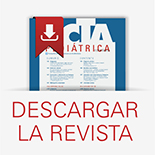Volumen 73 - Número 10 - Noviembre 2015
Publicado en
Nutrición infantil
La fibrosis quística en la actualidad (I): aspectos digestivos
Cystic fibrosis update time (I): digestive aspects
A. Sojo Aguirre, C. Bousoño García1Unidad de Fibrosis Quística. Hospital de Cruces. Barakaldo (Bizkaia). 1Unidad de Fibrosis Quística. Hospital Universitario Central de Asturias. Oviedo














